Walking on the Herodian street alongside the Western Wall in the Jerusalem Archaeological Garden and Davidson Centre, one sees an enormous pile of Herodian stones that clearly came from higher up the wall. The excavations in this area by the late Benjamin Mazar and later by Ronnie Reich have proved without a doubt that this destruction occurred in 70AD. The Herodian stones fell on a thin layer of destruction debris that contained many Herodian coins.

As reported first in Haaretz newspaper (in the Premium section which is available to subscribers only, but which was kindly forwarded by email to me by Joe Lauer) and later elsewhere, this view is now challenged by Shimon Gibson, who claims that these stones were destroyed by an earthquake that took place in 363 AD.
He reasons that a Roman bakery that was uncovered by Benjamin Mazar and published by his granddaughter Eilat, would not have been built next to a ruin.
“Who would buy bread in a place with damaged walls above it and fallen stones [adjacent to it]? You don’t build next to a four-story ruin.”
Obviously, people did build next to the four-story high Western Wall, as both the bakery and the Western Wall are still standing there today! We need to remember that the Temple Mount became a symbol of Jewish rebellion against Rome and therefore it was deliberately left in ruins.
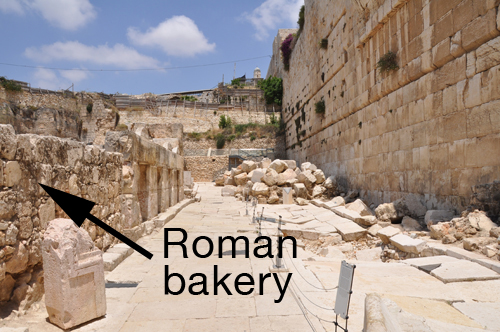
“Now we know much more about the late Roman period. If there was a neighborhood like this there, how could it be that they leave debris from the year 70 CE in the middle of it all? It’s like going out of your house and leaving a pile of debris. You clear it.”
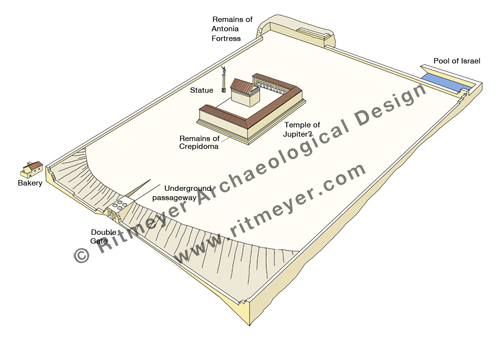
Well, that is easier said than done, as these stones were very heavy and difficult to move. Some stones were moved, but only for monumental building activities, such as the Damascus Gate, which was been partly built with Herodian stones in secondary use, and other projects such as the Nea Church and the Umayyad buildings. For smaller projects, such as dwellings, these Herodian stones were cut into smaller stones that were easier to handle.
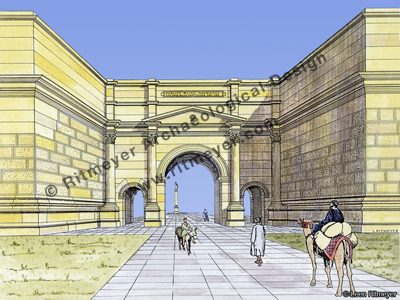
Additionally, as we will see below, there was no heavy stone debris where the bakery was built. The bakery was also not located next to the main Roman street in this area, called the Lower Cardo, but on a street of secondary importance, some distance away from it.
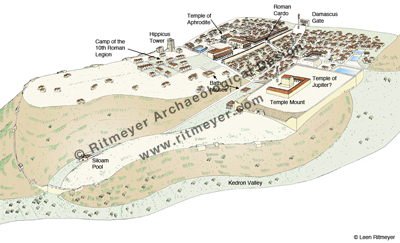
“Gibson believes the builders of these structures used the still-existing Temple Mount walls and imitated their architecture and design as an effort by the Church to show that it – not rabbinic Judaism – was the anointed successor to Temple Judaism.”
A close examination of these structures, however, shows that the Herodian stones in these buildings are in secondary use. They were taken from the Temple Mount wall and moved there.
Before making sweeping statements, one should carefully examine the evidence. What kind of “large building stones” do visitors today see lying on the Herodian street? Among the rectangular stones there are many pilaster stones that were toppled down from the upper part of the Western Wall where the western portico stood.
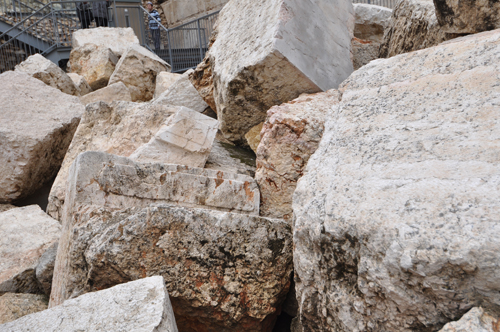
Josephus records that during the struggle for the Temple Mount, these porticoes were burnt and destroyed (War 6.191). The timber beams would have caught fire, the roof was destroyed and the pillars probably fell down on the Temple Mount, leaving only the outer wall, with its pilasters, standing. This upper part of the wall was pushed down by the Romans and fell on the street below, which was covered with a layer of burnt debris containing coins of the Jewish Revolt. Gibson‘s argument that these coins may have been deposited below these stones at a later date, goes against all archaeological logic.
The destroyed stones on the Herodian street were found in front of the pier of Robinson’s Arch as far as the northern edge of the excavations below the Mughrabi Gate ramp which leads up to the Temple Mount, but not south of this point.
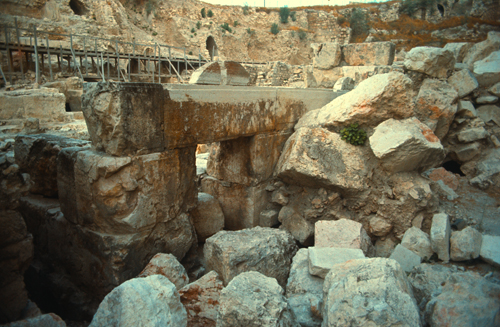
No such quantity of stones was found near the southwest corner where the Roman bakery was found.
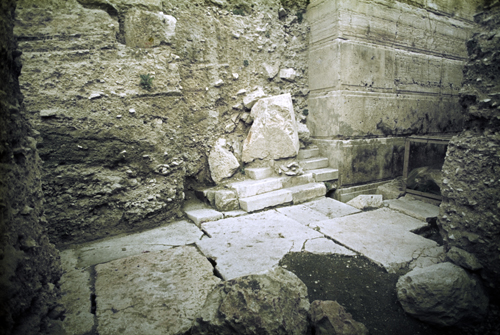
So, the bakery was not built in the middle of a pile of Herodian stones, as Gibson tries to infer that people believe. Of course, some rubble must have been cleared, but no gigantic mound of stones. That is clear also when one looks up. The Herodian southwest corner, as all other corners of the Herodian Temple Mount, has been preserved to a great height. Only the Trumpeting Stone and a few others were found here lying on the street.
Earthquakes can cause a lot of damage, as happened in 1927 when the al-Aqsa Mosque was almost entirely destroyed. But there is no evidence that an earthquake at any time ever dislodged stones from these massive 5m (15 feet) thick Herodian retaining walls. If the earthquake of 363 AD did destroy the Western Wall, where is the evidence? The heap of fallen Herodian stones is only three meters (10 feet) high. No stones were ever added on top of this, as this Roman destruction was covered by a late Roman bath house and Byzantine street level and drain. The Roman floor level was later covered over by the floor of an Umayyad palace. If the Western Wall was destroyed in 363 AD, then a large pile of stones would have been found on top of the Roman bath house and Byzantine street level which would have been completely destroyed, but no sign of this was found.
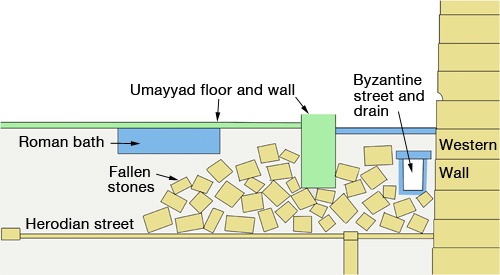
It is no wonder that “Gibson’s theory has been vehemently rejected by many.” Happily he said: “If I am wrong, then I am wrong. Life will go on.” I wish him all the best for the new year but think it unlikely that his proposal will cause an earthquake in how we understand this, one of the most significant and moving discoveries of the Temple Mount Excavations.
HT: Joe Lauer

thats fascinating info. we did visit there during our BLE this year. :}
Dear Prof.
Im feeling a bit giddy in that glad that before I read the opinion of a respected academic such as yourself on such news items, that I can deign for myself whether what he posited was possible and needs further study or outright ridiculous. Your books surely have taught me to appreciate what stories the remains of Jerusalem walls tell us, and that helped me in deciding that this fellow needs, with all respect, to go back to school. Maybe read your published works. So its a bit of fun that I rejected this claim right off based on my limited retention of the vast knowledge provided in “The Quest” and your “Secrets of the Temple Moun, enlarged and expanded edition. and of course, your teachings that you share with us here.
Prof. I beg your indulgence in clearing up something for me. The Dome of the Spirits/Tablets. But I did not find, while searching your books and other sources, the following answers.Was it built at the same time as the Shrine of Omar, who appropriated the honor from Abdel Malik, but forgot to change the dedication date, or Al Aqsa, or in-between sometime perhaps. And what would be the reason of it not being paved over by the Muslims as the rest of the Temple area has been?
And just as an aside Prof. I actually stood at this little Dome in 1989 faced the Mount of Olives and prayed and not quietly either, in Hebrew singing Psalms, not because I believed this was the Holy of Holies, but because the exposed surface had a spiritual effect on me. And non of the Waqfs henchmen nor the police standing several meters away did nothing. The fact that I stood on this spot in plain site flaunting the status quo and walked away unharmed, was to me a personal miracle.
I thank you Prof for any light you might be able to shed on this spot. Kol Kavod.
I am trying to picture this in my mind’s eye. If the earthquake of 363 CE caused the huge stones to fall, and if the Roman bath house was constructed before 363, when you dug down through the layers to reach the Roman bath house, you would have found the bath house pulverized by the stones, right? Did you find the stones we see today on the Roman street next to the western wall, UNDERNEATH the bathhouse when you removed the bath house? If so, it appears that they had to have fallen before the bath house was built over them, right? Is there a picture record of the excavations which ucovered the bath house and is it definitively dated to construction before the earthquake that Gibson is suggesting caused these stones to end up where they were found by archeologists digging down through the layers? Where can I go to see the progressive archeological excavation of the southwest corner of temple mount? I stood under the Robinson’s arch in 1982. I must have been ca. 30 feet above where I can now stand on the Herodian street that has been uncovered. It seems that such photographs of the archeological “uncovering” of the layers down to the Herodian street would establish pretty emphatically that the huge stones were waiting at the lowest level under the Roman bath house, if the bath house was built before 363 CE. Thanks.
Hi Richard,
Thanks for your question, which I have answered in today’s blog.
The Dome of the Spirits is an Ottoman structure, built in 1627, see: http://www.discoverislamicart.org/database_item.php?id=monument;ISL;pa;Mon01;31;en
The single stone slab on which it stands is a Herodian paving stone, one of the few that were left. It has nothing to do with the location of the Holy of Holies.
Ottoman? That late. I never would have guessed. Photos of the Temple Mount in the late 1800s show a terrible lack conservation. Broken cobblestones, weeds aplenty. Funny they built this and ignored all else. We call people who keep buildings in such shape, slumlords, but I would like to think that a Turkish Scholar perhaps convinced the builders to keep it honest and let the dome stand over the orginal paving as a tribute to the Temple Mount as a whole . Thank you Prof.